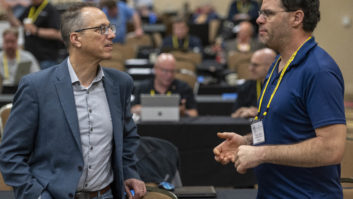Huzzah, public radio engineers.
Let’s take a moment to acknowledge something that has, in fact, been true for some time: Technical innovation in U.S. radio broadcasting is being led by public radio.
Need proof?
Tomorrow Radio – While commercial radio at large was still trying to get up the nerve to stick its toe in the digital waters, public radio was investing in research aimed at exploiting that technology beyond discussions of improved audio quality.
NPR announced its Tomorrow Radio initiative more than two years ago, in partnership with Harris and Kenwood USA. The first time someone described the concept to me, I said, “Commercial radio should be all over that – but it won’t, until someone else shows them how.”
HD Radio implementation – Public radio stations were among the first eager adopters of the digital technology, helped by the Corporation for Public Broadcasting, which began awarding grants in seed markets in late 2003. WUSF(FM) in Tampa threw the switch even earlier; it was the first public radio station to go digital, in February of that year.
ContentDepot – NPR Distribution is reengineering its program delivery to streamline how stations and producers select, send, acquire and automate programming.
Surround Sound – The first live HD Radio broadcast in surround? KUVO(FM) did it in Denver. The first U.S. attempt to create a distributed network feed of surround sound? The first U.S. broadcast of surround material on a national scale? NPR’s “Toast of the Nation” on Dec. 31.
The expanded PREC – Organizers have done an exceptional job at making the Public Radio Engineering Conference an informative event. Important technical speakers now are obliged to tack days onto their NAB plans to accommodate it.
Relationship with listeners
I asked Mike Starling at NPR why public radio seems to be out in front technically. He cited several reasons in a reply e-mail.
He said public radio engineers are fascinated by what can be done with the application of digital techniques. Further, “We love exploring the technical landscape with an impartial eye for what’s new and special – we frankly didn’t fret over whether the system ultimately adopted was IBOC, Eureka or McLane DAB, but do care mightily how any technology can be used to deepen the relationship with the radio listeners.”
There’s “great joy to be found, he said, with the realization that seamless digital booster technology may be near at hand, or that we can offer entirely new, high-quality services where we had just one before.”
Starling said public radio engineers, at least at NPR, work for executives who support them and are open to the world of possibilities, within a system that prides itself on public service.
“We have deep respect for scientific accuracy and rigor,” he continued. “We don’t put our name on a report to the FCC unless we are convinced it’s rock-solid. We believe inculcating a process of critical engineering analysis is both a means and an end, that it helps to spot inflection points in the marketplace.
“And last, and probably foremost, a heck of a lot of luck in the technology topics we’ve chosen to work on, seem to have gained some currency.”
Now, one could argue that public radio engineering innovation stands out more not because it has changed in the past 10 years, but because commercial radio changed around it. Consolidation and shrinking technical resources in the deregulated free market may be at work in altering our perceptions. And it’s true that public radio doesn’t answer to Wall Street and enjoys a funding mechanism not available to commercial radio (although Starling points out that CPB dollars comprise on average roughly 12 percent of local station revenues, and NPR in a typical year receives just 2 to 3 percent of its budget through competitive federal grants).
But these considerations are not only debatable; they strike me as beside the point. Ours is a technical industry, and we should be investing in its technical resources.
Starling finds it ironic that “in the midst of the greatest radio broadcast leap forward since Armstrong invented FM in 1933, we have no industry center for excellence or innovation. … Frankly, I suspect in hindsight that NPR has served in a de facto limited role to fill that need; but much of the work until now has been cobbled together in our copious spare time between 2 and 5 a.m.”
I agree. I’m grateful for the innovation and investment being made by public radio executives and engineers in our future.










